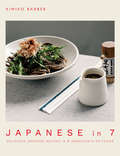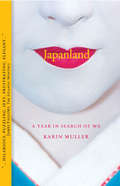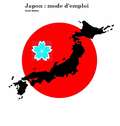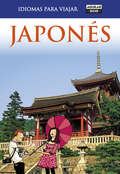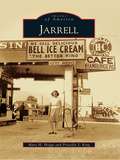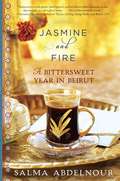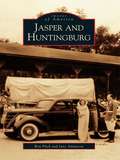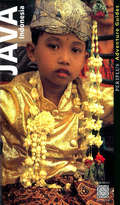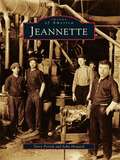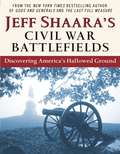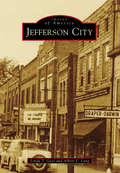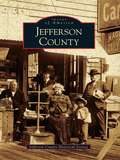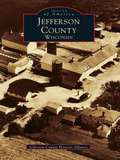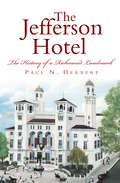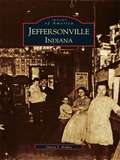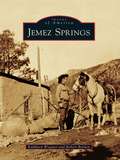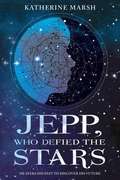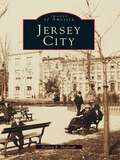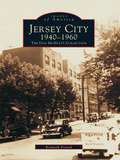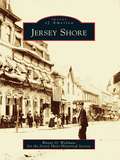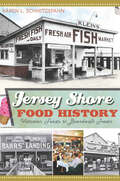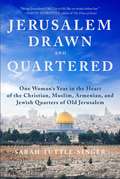- Table View
- List View
Japanese in 7: Delicious Japanese recipes in 7 ingredients or fewer
by Kimiko BarberJapanese food is healthy, delicious and universally enjoyed but despite the popularity of sushi and noodle bars worldwide too few of us cook this delightful cuisine at home. In Japanese in 7 (the latest addition to the in 7 series), Kimiko Barber uses just 7 ingredients or fewer to make deliciously fragrant dishes that you can effortlessly pull together any night of the week. Chapters are divided into:*Fresh - vibrant and healthy meals such as Yellowtail Sashimi, Hand-rolled Sushi and Japanese-style Duck Orange.*Fast - Meals like Dashi-rolled Omelette and Tuna Hotpot that can be on the table quickly after a long day at work.*Light - delicious recipes such as Japanese Onion Soup and Savoury Egg Tofu.*Vegan - nourishing plant-based recipes like Grilled Aubergine in Miso Soup and Mushroom Rice.*Comfort - bowls of warming Moon Udon, Chicken and Miso Porridge or Sea Bream Rice to enjoy on a cold winter's evening.*Sweet - creative Japanese desserts such as Matcha Jelly, Kyoto Tiramisu and Black Sesame Ice Cream.*Basics - Dashi and flavoursome dressings you can use to quickly create authentic Japanese dishes.
Japanland: A Year in Search of Wa
by Karin MullerDuring a year spent in Japan on a personal quest to deepen her appreciation for such Eastern ideals as commitment and devotion, documentary filmmaker Karin Muller discovered just how maddeningly complicated it is being Japanese. In this book Muller invites the reader along for a uniquely American odyssey into the ancient heart of modern Japan. Broad in scope and deftly observed by an author with a rich visual sense of people and place, Japanland is as beguiling as this colorful country of contradictions.
Japon: mode d'emploi
by Anne Brunet Turolo StefanoCeci n'est pas un guide touristique classique. Mais un guide qui vous aidera à passer des vacances idéales au Japon. Vous n'y trouverez pas les horaires des bus, la liste des restaurants ou celle des musées. On vous-y explique par contre comment prendre un bus, comment faire un billet de train ou comment se rendre dans les onsen. Un petit guide pour ne pas se sentir perdu au pays du Soleil-Levant...et éviter de passer pour un idiot.
Japonés (Idiomas para viajar #Volumen)
by El País-AguilarIdiomas para viajar ofrece ahora unos contenidos mucho más amplios y completos. Cada guía recoge todo lo que se necesita para desenvolverse durante el viaje: una guía de pronunciación, un resumen gramatical y un manual básico del idioma como introducción a todos los bloques temáticos pensados para resolver situaciones según avanza el viaje (llegada, desplazamientos, alojamiento, restaurantes, ocio, compras, salud, emergencias#). Un código de colores distingue los diferentes bloques temáticos para facilitar la consulta. Todos los capítulos tienen, además de introducciones prácticas del país, un vocabulario imprescindible y expresiones habituales, con sus correspondientes transcripciones. La guía concluye con un nuevo diccionario bilingüe, que contiene todas las palabras de uso habitual en la comunicación diaria.
Jarrell
by Priscilla S. King Mary H. HodgeIn 1909, real estate developer Orlando D. Jarrell had a vision: He would sell lots near the Bartlett Western Railroad site and name the town Jarrell. When the railroad bypassed the nearby town of Corn Hill and Jarrell's lots began to sell, the residents of Corn Hill--and their houses--moved to the promising, new town. Rock quarries became and are still a mainstay of this area, shipping limestone all over the world. About 200 vintage photographs illustrate the time between 1855 and more recent years, including the monstrous 1997 tornado that put Jarrell into the national spotlight.
Jasmine and Fire: A Bittersweet Year in Beirut
by Salma AbdelnourAs Beirut exploded with the bombs and violence of a ruthless civil war in the '80s, a nine-year-old Salma Abdelnour and her family fled Lebanon to start a new life in the States. Ever since then-- even as she built a thriving career as a food and travel writer in New York City--Salma has had a hunch that Beirut was still her home. She kept dreaming of moving back--and finally decided to do it.But could she resume her life in Beirut, so many years after her family moved away? Could she, or anyone for that matter, ever really go home again? Jasmine and Fire is Salma's poignant and humorous journey of try-ing to resettle in Beirut and fumbling through the new realities of life in one of the world's most complex, legendary, ever-vibrant, ever- troubled cities. What's more, in a year of roiling changes around the Middle East and the rise of the Arab Spring, Salma found herself in the midst of the turmoil, experiencing it all up close. As she comes to grips with all the changes in her life--a love left behind in New York and new relationships blossoming in Beirut--Salma takes comfort in some of Lebanon's enduring traditions, particularly its extraordinary food culture. Through the sights, sounds, and flavors of a city full of beauty, tragedy, despair, and hope, Salma slowly begins to reconnect with the place she's longed for her entire life.
Jasper and Huntingburg
by Jane Ammeson Ron FlickNestled in the rolling hills of Southern Indiana, Jasper and Huntingburg are quintessential American towns where hard work and dedication to cultural and ethnic preservation contribute to the beauty and prosperity of the area. The strong European roots of these Dubois County towns are evident in soaring churches and the nearby Monastery of the Immaculate Conception. German traditions passed down by immigrants from the Black Forest and Bavaria have earned Jasper the title of the "Nation's Woodworking Capital," while Scotch and Irish heritage are also woven into the fabric of the region. These divergent influences have created architecturally and historically significant towns proud of their past and ready to embrace their future.
Java Adventure Guide
by Periplus EditorsThe ultimate adventure guideThis is the most comprehensive guide to Java ever produced. Hundreds of pages of travel tips and dozens of lively articles on history, nature, and the arts, take you right under the surface of Javanese life, with visits to lots of unique places.Under the volcanoJava's 121 active volcanoes rumble and roar above one of the world's most dramatic tropical landscapes. Whether you come here to trek the volcanoes or to visit the island's impressive ancient monuments, Java provides the adventure of a lifetime.The nitty gritty, from A to ZDetailed maps of all areas of interest are included along with personal recommendations from our expert authors on how to get around, where to stay and eat, and how to get the best value for your money.
Java Adventure Guide
by Periplus EditorsThis is the most comprehensive guide to Java ever produced. Hundreds of pages of travel tips and dozens of lively articles on history, nature and the arts, take you right under the surface of Javanese life, with visits to lots of unique places. Detailed maps of all areas of interest are included along with personal recommendations from our expert authors on how to get around, where to stay and eat, and how to get the best value for your money.
Java Indonesia
by Periplus EditorsUnder the volcano Java’s 121 active volcanoes rumble and roar above one of the world’s most dramatic tropical landscapes. Whether you come here to trek the volcanoes or to visit the island’s impressive ancient monuments, Java provides the adventure of a lifetime. The ultimate adventure guide This is the most comprehensive guide to Java ever produced. Hundreds of pages of travel tips and dozens of lively articles on history, nature, and the arts, take you right under the surface of Javanese life, with visits to lots of unique places. The nitty gritty, from A to Z Detailed maps of all areas of interest are included along with personal recommendations from our expert authors on how to get around, where to stay and eat, and how to get the best value for your money.
Jaywalking with the Irish
by David MonaganFrom the book: For David Monagan, born in Connecticut to a staunch Irish-American family, a lifelong interest in Ireland was perhaps inescapable. David studied literature at Dublin's Trinity College in 1973 and '74, and he became captivated by the country. After enjoying many visits in the intervening years, in 2000 David and his family relocated from the U.S. to Cork, Republic of Ireland. David has written for numerous publications, including the Irish Times, Sunday Independent, and Irish Examiner, and in his wide travels has developed a keen eye for things baffling and marvelous, such as he finds everywhere around him in modern-day Ireland.
Jeannette
by John Howard Terry PerichJeannette, the Glass City, was named in honor of H. Sellers McKee's wife and was the first large manufacturing town within Westmoreland County. On May 20, 1889, the first glass was blown, and Jeannette began sending its glass products all over the world. There were seven great glass factories located in the area, as well as the largest pressed-glass factory in America and the largest window glass plant in the world. Two of the largest factories in the world were the McKee Brothers' Works and the Chambers-McKee Glass Company. Jeannette produced more glass in various forms than any other place in the United States. Jeannette was also home to Oakford Park, a trolley park, for the relaxation of its citizens and those in the surrounding areas. The great Oakford Park flood, which took place on July 5, 1903, was the most devastating event in western Pennsylvania since the Johnstown flood of 1889. Oakford Park was rebuilt, and Jeannette recovered and continued producing glass.
Jeff Shaara's Civil War Battlefields: Discovering America's Hallowed Ground
by Jeff ShaaraTRAVEL THROUGH A PIVOTAL TIME IN AMERICAN HISTORY. Jeff Shaara, America's premier Civil War novelist, gives a remarkable guided tour of the ten Civil War battlefields every American should visit: Shiloh, Antietam, Fredericksburg/Chancellorsville, Gettysburg, Vicksburg, New Market, Chickamauga, the Wilderness/Spotsylvania, Cold Harbor, and Petersburg/Appomattox. Shaara explores the history, the people, and the places that capture the true meaning and magnitude of the conflict and provides* engaging narratives of the war's crucial battles* intriguing historical footnotes about each site* photographs of the locations-then and now* detailed maps of the battle scenes* fascinating sidebars with related points of interest. From Antietam to Gettysburg to Vicksburg, and to the many poignant destinations in between, Jeff Shaara's Civil War Battlefields is the ideal guide for casual tourists and Civil War enthusiasts alike. From the Trade Paperback edition.
Jefferson City (Images of America)
by Albert L. Lang Linda T. GassIn 1788, Adam and Elizabeth Peck followed the Holston River from Virginia into east Tennessee and settled in what would become Mossy Creek. Utilizing the waterway, the Pecks' gristmill thrived within a growing community. The outbreak of the Civil War brought the Battle of Mossy Creek on December 29, 1863. During the next century, zinc mining, the establishment of Mossy Creek Missionary Baptist Seminary (now Carson-Newman University), and the town's inclusion as a stop on the new railroad ushered a steady flow of people to this picturesque region of promise. In 1901, Mossy Creek joined the Carsonville and Frame Addition communities to be incorporated as Jefferson City. The Tennessee Valley Authority began work in 1940 on nearby Cherokee Dam, generating both jobs and tourism.
Jefferson County
by Jefferson County Historical SocietyFounded by optimistic speculators with dreams of commercial empires that never materialized, Jefferson County is located on Washington's Olympic Peninsula. It stretches from spectacular Pacific Ocean beaches on the west and the Strait of Juan de Fuca on the north to the forested banks of the Hood Canal on the east. Created by the Oregon territorial legislature in 1852 and redefined by the Washington Territorial Legislature in 1877, it was named for Pres. Thomas Jefferson. Scenic Olympic National Park and Olympic National Forest occupy 60 percent of the county, and important industries in the region have included logging, pulp and paper, fishing, dairy farming, boatbuilding, and other marine-related businesses. Today the county has been discovered by artists, writers, poets, retirees, and tourists drawn to its unmatched scenery, mild weather, outstanding recreational opportunities, and the absence of urban stress.
Jefferson County, Wisconsin (Images of America)
by Jefferson County Historic AllianceJefferson County holds a unique place in the history of the state of Wisconsin. Founded in 1836 by Yankee settlers from New England, it began as an agriculturally-based county but soon rose to prominence as the cradle of the dairy industry. Nestled in the valley of the Rock River in southeastern Wisconsin, Jefferson County has always figured prominently in the history of the state due to its proximity to both Milwaukee, Wisconsin's largest city, and Madison, the state capital. Jefferson County, Wisconsin looks at the history of this area from 1836 to the present day. The historic images and informative text allow the reader to view changes in industry, gain greater insight into the history of education, and better understand the historic roles that religion and the ever-important rivers have played in defining Jefferson County. By the beginning of the twentieth century, and for many years after, Jefferson County was the leader in the dairy industry. Education also played an important role in the makeup of the county's character. Such important educational milestones as the first kindergarten in America, founded in Watertown in 1856, and the first free textbooks in the state bearwitness to the county's commitment to the educational betterment of its children. Since the 1960s, much has changed in Jefferson County, and this book will serve as a permanent record of itswonderful history, which is sometimes too easily forgotten.
Jefferson Hotel, The: The History of a Richmond Landmark (Landmarks)
by Paul N. HerbertDesigned by Richmond visionary Lewis Ginter, The Jefferson Hotel has been an icon in the community since 1895. From the alligators that used to roam the elegant lobby to the speakeasy housed within during Prohibition, the hotel has a fascinating and unparalleled history. Playing host to cultural icons like Charles Lindbergh and F. Scott Fitzgerald and surviving the Great Depression and catastrophic fires, the hotel has remained an important landmark throughout Richmond's history. Join local historian Paul Herbert as he recounts stories of heiresses, actors, musicians and celebrities in this all-encompassing history of The Jefferson, a volume bound to delight anyone who has ever stayed within its treasured walls.
Jeffersonville, Indiana
by Garry J. NokesThe Ohio River has nurtured Jeffersonville. The city's prime location, a bend in the river before the Falls of the Ohio, fostered its development into a regional hub of transportation and commerce. From time to time, however, the river lashes out at those who inhabit its shores. The frigid waters of winter and early spring sometimes swallow the city, leaving mud, disease, and devastation in their wake. The more than two hundred images featured in Jeffersonville, Indiana tell the city's tale from the earliest days of settlement, through the boom days of the late 19th century, and on to the tragedy of the Great Flood in 1937. Those who observed the bawdy days of Jeffersonville's marriage parlors, gambling halls, and saloons called the city "Little Chicago." Those who marveled at the diversity of its religious establishments called it the "City of Churches." Citizens of Jeffersonville enjoyed its nightlife on Saturday and filled its pews on Sunday, but have never failed to work hard throughout the week.
Jemez Springs
by Robert Borden Kathleen WiegnerIn 1849, James Hervy Simpson, a lieutenant and engineer in the Army Corps of Topographical Engineers, was ordered to survey a wagon road as a southern alternative to the Santa Fe Trail from Fort Smith, Arkansas, to Santa Fe, New Mexico. Simpson hired two brothers, Edward "Ned" and Richard Kern, to provide survey sketches that included the pueblo ruins of Giusewa and natural hot springs of Ojo Caliente, which are known today as Jemez Springs. Prior to incorporation in 1955, Jemez Springs, like many frontier towns, was supported by ranching, logging, and mining. It also had an influx of tourists who enjoyed the hot springs or one of the many dude ranches in the area. In 1995, Jemez Springs won an award as an All-America City from the National Civic League, and with a mere 375 residents at the time, it was one of the smallest communities to earn the honor.
Jepp, Who Defied The Stars
by Katherine MarshFate: Is it written in the stars from the moment we are born? Or is it a bendable thing that we can shape with our own hands? Jepp of Astraveld needs to know. He left his countryside home on the empty promise of a stranger, only to become a captive in a luxurious prison: Coudenberg Palace, the royal court of the Spanish Infanta. Nobody warned Jepp that as a court dwarf, daily injustices would become his seemingly unshakable fate. If the humiliations were his alone, perhaps he could endure them; but it breaks Jepp's heart to see his friend Lia suffer. After Jepp and Lia attempt a daring escape from the palace, Jepp is imprisoned again, alone in a cage. Now, spirited across Europe in a kidnapper's carriage, Jepp fears where his unfortunate stars may lead him. But he can't even begin to imagine the brilliant and eccentric new master-a man devoted to uncovering the secrets of the stars-who awaits him. Or the girl who will help him mend his heart and unearth the long-buried secrets of his past. Masterfully written, grippingly paced, and inspired by real historical characters, Jepp, Who Defied the Stars is the tale of an extraordinary hero and his inspiring quest to become the master of his own destiny.
Jersey City (Images of America)
by Patrick B. ShalhoubPatrick Shalhoub has brought together over two hundred fascinating photographs and prints of Jersey City which bring to life the people, places, and events which have created the city's vibrant and colorful history over the centuries. He takes us on a journey into the past. We see the farming communities which dominated the locality from the 1660s through the middle of the nineteenth century, when the area was part of the larger Bergen Township. We then experience the arrival of the immigrants, the advent of industrialization, and the rapid growth of Jersey City from a cluster of farmsteads and villages into the second largest city in New Jersey. Immigration has been the lifeblood of Jersey City's history, and through the images selected here we witness how Jersey City sprang to life with the influx of immigrants between 1830 and 1920-at first, Irish, German, and British, and, later, immigrants from southern and eastern Europe, including Italians, Poles, Russians, and Slovaks. African-Americans were present in Bergen Township from the early days of the city, but their numbers increased with the migration of laborers from the South in the first half of the twentieth century and their important contribution to the city continued. In recent decades, new communities have grown in Jersey City, including Latin American, Asian Indian, Egyptian, Filipino, and Haitian communities.
Jersey City 1940-1960: The Dan McNulty Collection
by Kenneth FrenchPhotographer Dan McNulty was a Jersey City resident who spent most of his time working in his family's funeral home. McNulty's photography was a mere sideline, but this fact did not affect the high artistic quality of the images of the city that he produced during the 1940s and '50s. During the two decades of McNulty's work, Jersey City experienced many changes. The powerful political machine of Mayor Frank Hague was brought down after thirty yearsin 1949 by the reform team of John V. Kenny, and this period also saw the end of the city's success in the railroad industry. In the 1950s, the first large housing projects were constructed in the city; other sweeping developments in this sphere would follow in the 1960s. McNulty documented these changes and others that resulted during this twenty year period through dramatic photographs of vacant railroad terminals, dynamic commercial and residential districts, successful factories and manufacturing plants, and significant WPA projects such as the Jersey City Medical Center and Roosevelt Stadium.
Jersey Shore
by Wayne O. Welshans Jersey Shore Historical SocietyJersey Shore, a small town with a seemingly misplaced name, was on the edge of the western frontier during Revolutionary War days, and those who settled in this area prior to 1784 found themselves outside the jurisdiction of both Great Britain and the commonwealth. Out of this was produced a Fair Play society, the Pine Creek Declaration of Independence, and something known as the Big Runaway. By 1800, a little village began to form along the banks of the west branch of the Susquehanna River. Over time, the West Branch Canal, lumbering, and a very large New York Central Railroad shop brought growth and prosperity to the area. Jersey Shore presents a visual story of the area through pictures taken by local photographers, including Joseph Mick, William H. Garman, and Jonathan Potter, dating from Civil War days to around 1930.
Jersey Shore Food History: Victorian Feasts to Boardwalk Treats (American Palate Ser.)
by Karen L Schnitzphan&“Chock full of photographs, the book dishes on food from the mid-1800s to the mid-1900s, all along the coast from Sandy Hook to Cape May.&” —RedBankGreen No trip to the Jersey Shore would be complete without indulging in the cuisine that helps make it famous. These foods we enjoy today are part of a long tradition beginning in the Victorian era, when big oceanfront hotels served elaborate meals. Diverse dishes and restaurants emerged during prohibition and the Great Depression, when fast food appeared and iconic boardwalk treats developed. Predating the farm to table movement, fancy and fast eateries have been supplied by local fishermen and farmers for decades. So whether you indulge in a tomato pie, pork roll or salt water taffy, take a mouthwatering historical tour and discover timeless treats from Sandy Hook to Cape May. &“Tells the story of the original farm and sea to table American destination. The book is filled with information about the way the NJ shore has eaten through history and the food establishments that have spanned generations, some still operating today.&” —NJ.com &“This book also gives us insights into the earliest days of Atlantic City&’s fine hotels. The Victorian era menus included in the volume are a treasure. I also loved her inclusion of such iconic former restaurants as Hackney&’s and Capt. Starn&’s and the still standing Knife and Fork Inn.&” —Atlantic City Central &“If you enjoy walking the Boardwalk for your pork roll and salt water taffy fix, or if you appreciate the history of the region&’s former great restaurants like Hackney&’s, Capt. Starn&’s and Zaberer&’s, this book will be an entertaining read.&” —Atlantic City Weekly
Jerusalem, Drawn and Quartered: One Woman's Year in the Heart of the Christian, Muslim, Armenian, and Jewish Quarters of Old Jerusalem
by Sarah Tuttle-SingerOn a night in 1999 when Sarah Tuttle-Singer was barely 18, she was stoned by Palestinian kids just outside one of the gates to the Old City of Jerusalem. In the years that followed, she was terrified to explore the ancient city she so loved. But, sick of living in fear, she has now chosen to live within the Old City's walls, living in each of the four quarters: Christian, Muslim, Armenian, and Jewish. Jerusalem’s Old City is the hottest piece of spiritual real estate in the world. For millennia empires have clashed and crumbled over this place. Today, the conflict between Israelis and Palestinians plays out daily in her streets, and the ancient stones run with blood. But it’s also an ordinary city, where people buy vegetables, and sooth colicky babies, where pipes break, where the pious get high, and young couples sneak away to kiss in the shadows. Sarah has thrown herself into the maelstrom of living in each quarter—where time is measured in Sabbath sunsets and morning bells and calls to prayer, in stabbing attacks and check points—keeping the holidays in each quarter, buying bread from the same bread seller, making friends with people who were once her enemies, and learning some of the secrets and sharing the stories that make Jerusalem so special, and so exquisitely ordinary. Jerusalem, Drawn and Quartered is a book for anyone who’s wondered who really lives in Israel, and how they coexist. It’s a book that skillfully weaves the personal and political, the heartwarming and the heart-stopping. It’s a book that only Sarah Tuttle-Singer can write. The Old City of Jerusalem may be set in stone, but it’s always changing—and these pages capture that.
